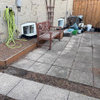Hello, I've searched and read LOTS of threads in various forums here, but haven't seen anything that matches my situation *quite* well enough to answer my concerns - I'm new here, so please forgive me if I've overlooked something or am posting this in the wrong place!
I live in the Willamette Valley in Oregon, right up against the foothills of the Coast Range. The 'native' soil in my area is heavyyy compacted clay, so I've been putting in raised beds for everything - vegetables, herbs, lots of berries, some small fruit trees. Last year I filled some beds with straight compost (municipal, but 'approved for organic use'), and some beds with a mix of same compost + coir, sand, pumice + small amendments (limestone, oyster shell, etc) - I based the various mixes on Richo Cech's recipes in 'The Medicinal Herb Grower'.
This year, the compost-only beds are MUCH compacted and hardened and 'crusty', while the 'mix' beds have much softer texture and drainage, not near as much shrinkage - well, I s'pose that's not a huge surprise, really.
But okay, now HERE'S my problem - the mix I made last year was, in the end, SUPER expensive (and a major project to mix, given my small working area - soaking coir in the wheelbarrow, mixing on a tarp on the driveway, etc)- and, the more I ponder the coir, I'm really not feeling good about using a material that has NO native relation to this area and comes from so far away - I decided to use it in place of peat (which I stay away from altogether for several reasons), but yeah, upon further consideration I'm not so sure the coir is such a good choice either, for here, for me.
Now - the same place I got the municipal compost also does custom mixes - they don't have coir anyway, and they DO have peat but I don't want to go that way - but, they also have various grades of bark chips, along with sand and pumice and of course the straight compost.
So FINALLY, HERE'S MY ACTUAL QUESTION: Could I use wood chips in place of coir/peat? My chip options (with descriptions directly from their website) are -
Medium Fir - Deep red, freshly ground fir bark screened to 3/4". A great topdressing for planting beds; also use as a filler component in potting mix.
Premium Fir - Aged ground fir bark with a deep red color and screened to 1/2". A premium topdressing for planting beds; also use as a filler component in potting mix.
Hemlock - Aged ground hemlock bark screened to 3/4"; chocolate brown color. A sliverless topdressing for planting beds; ideal for people with children or pets.
Alder Sawdust - Ground and shipped directly from a local alder mill. Excellent for frost prevention, mud control and bird deterrent or as a thin topdressing to retain moisture in recently seeded lawns.
Cedar Chips - Cedar woodchips sized to 2" to 4". A long-lasting barkdust alternative, cedar chips make excellent
bedding for pathways, play areas and kennels.
...So, what about the premium aged fir (and/or the fresh medium fir?), mixed with the compost and pumice - and sand? - orrr, they also have what they call 'sandy loam topsoil', which by itself appears wayyy more 'sandy' (gritty, dry) than 'loamy' or 'topsoilish', but could also be used as part of a mix. WHICH elements would you advise I include, AND, in what proportions?? Can I put together a 'complete' mix from the available materials, or would I still need to add in *something* to round it out? I've read that fresh chips can lock up nitrogen, apparently, but is their larger size an advantage over the finer aged chips? Like, maybe using them as a mulch, rather than mixing-in?? Or...??!!?
I'm at the point of having pondered this SO much that I can't think straight anymore - I've seen that there's lots of super-knowledgeable-experienced folks here, so any help sorting this out would be sooo much appreciated!














oliveoyl3
UserOriginal Author
Related Discussions
Not happy with new soil in my brand new raised vegetable bed
Q
help with raised bed soil mix
Q
Soil Mix for Raised Beds
Q
Premade Raised Bed soil - is this mix ideal?
Q
gardenlen
gardengal48 (PNW Z8/9)
UserOriginal Author
oliveoyl3